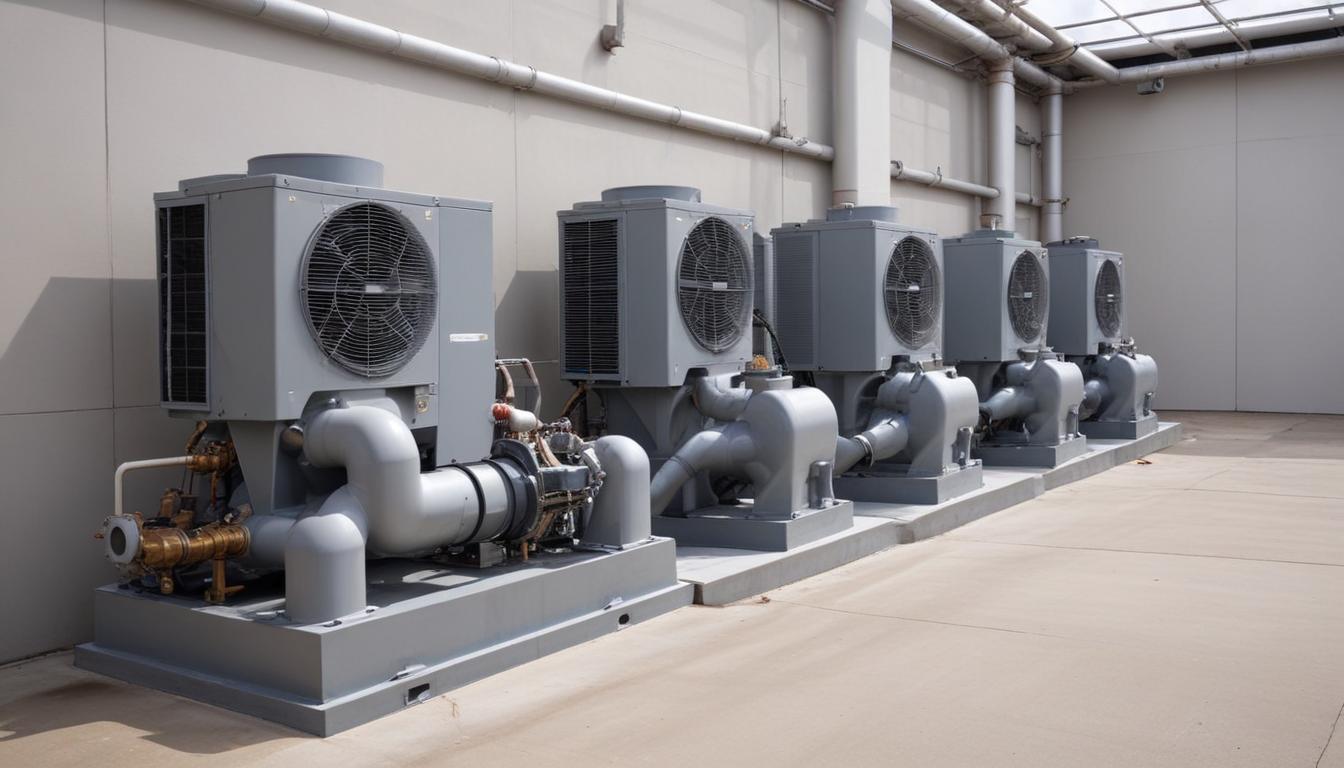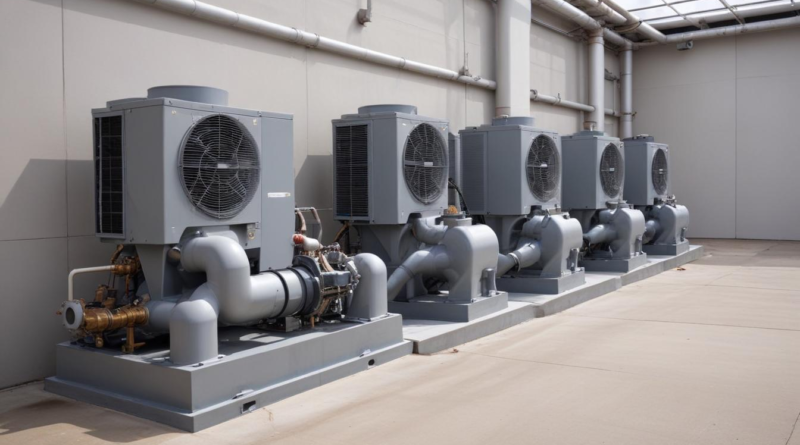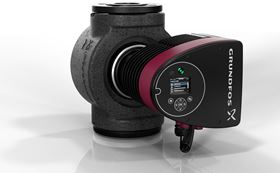the role of pumps in HVAC cooling
In HVAC cooling systems, pumps play a crucial role in ensuring efficient and effective temperature regulation within buildings. These HVAC cooling pumps are responsible for the continuous circulation of the coolant, typically water or a water-glycol mixture, through various components of the system. This circulation is essential for absorbing heat from indoor air and releasing it outdoors, thereby maintaining desired indoor temperatures.
The primary functionality of pumps in HVAC systems includes:
- Circulation of Coolant: Pumps move the coolant through the evaporator, where it absorbs heat from the indoor air, and then to the condenser, where the heat is dissipated outside.
- Maintaining System Pressure: Proper pressure levels within the system are essential for optimal heat exchange. Pumps ensure that the coolant maintains the necessary pressure to facilitate efficient heat transfer.
- Balancing Flow Rates: In complex HVAC systems with multiple zones or areas, pumps help balance the flow rates to ensure uniform cooling throughout the space.
- Enhancing System Efficiency: By providing consistent and reliable coolant movement, pumps contribute to the overall energy efficiency of the HVAC system, reducing operational costs.
Additionally, the integration of pumps with control systems allows for adaptive responses to varying cooling demands. For instance, variable speed pumps can adjust their operation based on real-time temperature readings, optimizing performance and conserving energy when full capacity is not required.
A typical HVAC cooling pump system includes several key components, organized as follows:
| Component | Function |
|---|---|
| Pump Motor | Drives the pump to circulate the coolant through the system. |
| Impeller | Creates the flow by imparting velocity to the coolant. |
| Seals and Bearings | Ensure leak-free operation and support the moving parts. |
| Control Valves | Regulate the flow rate and pressure of the coolant. |
Understanding these functions and components is essential for designing, operating, and maintaining efficient HVAC cooling systems. Proper pump selection and maintenance directly influence the system’s reliability, energy consumption, and overall performance, highlighting the indispensable role of pumps in HVAC applications.
types of pumps used for cooling
In the realm of HVAC cooling pumps, various types are employed to meet the diverse requirements of different cooling applications. Selecting the appropriate pump type is crucial for ensuring optimal performance, reliability, and energy efficiency. The primary categories of pumps used for cooling include centrifugal pumps, positive displacement pumps, and vertical inline pumps.
- Centrifugal Pumps: These are the most commonly used pumps in HVAC systems due to their simplicity and efficiency. Centrifugal pumps operate by converting rotational kinetic energy into hydrodynamic energy, which moves the coolant through the system.
- Positive Displacement Pumps: Unlike centrifugal pumps, positive displacement pumps move fluid by trapping a fixed amount and forcing it through the system. They are typically used in applications requiring precise flow control.
- Vertical Inline Pumps: Designed for installations where space is limited, vertical inline pumps integrate the motor and pump into a single unit, reducing the overall footprint and simplifying installation.
Each pump type offers unique advantages tailored to specific cooling needs:
| Pump Type | Advantages | Typical Applications |
|---|---|---|
| Centrifugal Pumps |
|
|
| Positive Displacement Pumps |
|
|
| Vertical Inline Pumps |
|
|
Additionally, advancements in pump technology have introduced variable speed pumps, which adjust their operating speed based on the cooling demand. This adaptability enhances the functionality and energy efficiency of HVAC systems by matching the pump performance to real-time requirements, thereby reducing energy consumption and operational costs.
When selecting a pump type, considerations such as the size of the HVAC system, the required flow rate, pressure conditions, and installation constraints must be evaluated. Understanding the specific characteristics and benefits of each pump type ensures that the chosen HVAC cooling pump aligns with the system’s operational needs, contributing to overall system reliability and efficiency.
energy efficiency and pump selection
Energy efficiency is a critical factor in the selection of pumps for HVAC cooling systems, influencing both operational costs and environmental impact. By choosing the right pump, facilities can significantly reduce energy consumption while maintaining optimal cooling performance. The selection process involves evaluating several key aspects to ensure that the pump aligns with the system’s requirements and promotes sustainable operation.
Factors Influencing Pump Selection for Energy Efficiency:
- Flow Rate Requirements: Determining the necessary flow rate is essential. Pumps must provide sufficient coolant circulation to meet the cooling demands without exceeding energy capacity.
- Head Pressure: This refers to the pressure required to move the coolant through the HVAC system. Selecting a pump that matches the system’s head pressure ensures efficient operation.
- System Configuration: The layout and complexity of the HVAC system, including the number of zones and length of piping, affect pump selection. A well-matched pump can handle the specific dynamics of the system efficiently.
- Variable versus Fixed Speed: Variable speed pumps adjust their operation based on real-time cooling needs, offering significant energy savings compared to fixed speed pumps that run at constant capacity.
- Pump Efficiency Curves: Analyzing pump performance curves helps in selecting a pump that operates near its peak efficiency point under typical conditions, minimizing energy wastage.
Energy-Efficient Technologies in Pumps:
Modern pump technologies have introduced several features that enhance energy efficiency, making them suitable for contemporary HVAC applications. Key advancements include:
| Technology | Description | Benefits |
|---|---|---|
| Variable Frequency Drives (VFDs) | VFDs adjust the motor speed based on the cooling demand, allowing the pump to operate only as hard as necessary. |
|
| Energy Recovery Systems | These systems capture and reuse energy from the HVAC process, improving overall system efficiency. |
|
| Advanced Motor Designs | Incorporates high-efficiency motors that consume less power for the same output compared to standard motors. |
|
Selection Guidelines for Maximizing Energy Efficiency:
- Conduct a Detailed System Analysis: Assess the specific cooling requirements, including peak and off-peak demands, to determine the appropriate pump size and type.
- Evaluate Pump Efficiency Ratings: Choose pumps with high energy efficiency ratings, such as those certified by ENERGY STAR or similar organizations.
- Consider Total Cost of Ownership (TCO): While energy-efficient pumps may have higher upfront costs, they offer long-term savings through reduced energy bills and maintenance expenses.
- Incorporate Smart Controls: Utilize intelligent control systems that can optimize pump operation based on real-time data, enhancing both efficiency and system performance.
- Regularly Maintain and Monitor Pumps: Ensure that pumps operate at peak efficiency by performing routine maintenance and monitoring performance metrics to identify and address issues promptly.
Benefits of Selecting Energy-Efficient Pumps:
Adopting energy-efficient pumps in HVAC cooling systems delivers multiple advantages beyond cost savings:
- Reduced Environmental Impact: Lower energy consumption translates to decreased greenhouse gas emissions, contributing to environmental sustainability.
- Enhanced System Reliability: Efficient pumps experience less wear and tear, resulting in fewer breakdowns and longer service life.
- Compliance with Regulations: Meeting energy efficiency standards and regulations can avoid penalties and support certification processes for buildings.
- Improved Performance: Efficient pumps ensure stable and consistent cooling performance, enhancing occupant comfort and system effectiveness.
In summary, prioritizing energy efficiency in pump selection not only optimizes the performance and reliability of HVAC cooling systems but also aligns with broader sustainability goals. By carefully evaluating system requirements and leveraging advanced pump technologies, organizations can achieve significant energy savings and operational benefits.
maintenance and troubleshooting
 Proper maintenance is essential to ensure the reliability and efficiency of HVAC cooling pumps. Regular upkeep not only extends the lifespan of the pumps but also ensures they operate at optimal performance levels, minimizing downtime and preventing costly repairs. A comprehensive maintenance program coupled with effective troubleshooting strategies can significantly enhance the functionality of HVAC systems.
Proper maintenance is essential to ensure the reliability and efficiency of HVAC cooling pumps. Regular upkeep not only extends the lifespan of the pumps but also ensures they operate at optimal performance levels, minimizing downtime and preventing costly repairs. A comprehensive maintenance program coupled with effective troubleshooting strategies can significantly enhance the functionality of HVAC systems.
Preventive Maintenance Tasks:
- Regular Inspection: Periodically examine the pump for signs of wear, corrosion, or leakage. Check all connections and seals to ensure there are no leaks that could compromise system integrity.
- Lubrication: Ensure that all moving parts, such as bearings and shafts, are adequately lubricated. Proper lubrication reduces friction, preventing excessive wear and overheating.
- Filter Replacement: Clean or replace filters regularly to prevent clogs that can restrict coolant flow and reduce pump efficiency.
- Alignment Checks: Verify that the pump and motor are correctly aligned. Misalignment can lead to increased vibration, which may cause premature component failure.
- Electrical Inspections: Inspect electrical connections for signs of wear or corrosion. Ensure that wiring is secure and free from damage to prevent electrical faults.
- Performance Testing: Conduct routine performance tests to ensure the pump is operating within specified parameters. Monitor flow rates, pressure levels, and energy consumption to detect any deviations.
Common Issues and Troubleshooting:
| Problem | Possible Causes | Solutions |
|---|---|---|
| Pump Not Operating |
|
|
| Unusual Noise |
|
|
| Reduced Flow Rate |
|
|
| Overheating |
|
|
Best Practices for Maintenance and Troubleshooting:
- Create a Maintenance Schedule: Develop a detailed schedule outlining all maintenance tasks, ensuring they are performed regularly and systematically.
- Train Personnel: Ensure that maintenance staff are adequately trained to perform inspections, maintenance, and troubleshooting effectively.
- Use Quality Parts: When replacing components, use high-quality parts that meet the manufacturer’s specifications to maintain system integrity.
- Document Maintenance Activities: Keep detailed records of all maintenance and repair work. This documentation helps in identifying recurring issues and planning future maintenance activities.
- Monitor System Performance: Utilize monitoring tools and sensors to continuously track the performance of HVAC cooling pumps, enabling early detection of potential problems.
- Implement Predictive Maintenance: Leverage data analytics and predictive tools to anticipate failures before they occur, allowing for proactive maintenance interventions.
Tools and Techniques for Effective Troubleshooting:
- Multimeters and Electrical Testers: Essential for diagnosing electrical issues, such as motor faults or power supply problems.
- Flow Meters and Pressure Gauges: Used to measure flow rates and system pressure, helping identify performance deviations.
- Vibration Analyzers: Detect unusual vibrations that may indicate mechanical issues like misalignment or bearing wear.
- Thermal Cameras: Identify overheating components or areas with insufficient cooling.
- Leak Detection Kits: Useful for locating and addressing leaks within the pump and coolant pathways.
Implementing a robust maintenance and troubleshooting regimen not only preserves the functionality of HVAC cooling pumps but also enhances the overall efficiency and reliability of the cooling system. By addressing issues promptly and maintaining regular upkeep, facilities can ensure consistent performance, reduce operational costs, and extend the lifespan of their HVAC investments.
future trends in pump technology
Advancements in pump technology are continuously shaping the future of HVAC cooling systems, driving improvements in efficiency, reliability, and integration. Emerging trends focus on enhancing the functionality of pumps while addressing the growing demand for sustainable and intelligent building solutions. Key future trends include the integration of Internet of Things (IoT), adoption of advanced materials, development of smart pump systems, and increased emphasis on energy optimization.
- Internet of Things (IoT) Integration: The incorporation of IoT technology allows HVAC cooling pumps to be interconnected with other building systems. This connectivity enables real-time monitoring, remote diagnostics, and predictive maintenance, enhancing the overall role of pumps in maintaining system efficiency.
- Advanced Materials: The use of advanced materials such as corrosion-resistant alloys and lightweight composites improves pump durability and performance. These materials extend the lifespan of HVAC cooling pumps and reduce maintenance requirements.
- Smart Pump Systems: Smart pumps equipped with artificial intelligence (AI) and machine learning algorithms can adapt to changing environmental conditions and operational demands. These systems optimize pump performance automatically, ensuring optimal coolant circulation and energy usage.
- Energy Optimization Technologies: Innovations such as variable frequency drives (VFDs) and high-efficiency motors continue to evolve, providing greater control over pump operation and reducing energy consumption. Enhanced energy optimization aligns with global sustainability goals and lowers operational costs.
- Modular and Scalable Designs: Future pump designs emphasize modularity and scalability, allowing for easy expansion and customization of HVAC systems. This flexibility ensures that pumps can meet the evolving cooling needs of diverse applications, from small buildings to large industrial complexes.
Integration of IoT and Smart Technologies:
The integration of IoT in HVAC cooling pumps revolutionizes how these systems are managed and maintained. By connecting pumps to a network of sensors and control devices, facility managers can gain comprehensive insights into pump performance and system health.
| IoT Feature | Description | Benefits |
|---|---|---|
| Real-Time Monitoring | Continuous tracking of pump parameters such as flow rate, pressure, and energy consumption. |
|
| Predictive Maintenance | Utilizing data analytics to predict potential failures before they occur. |
|
| Remote Control and Automation | Ability to control pump operations remotely and automate responses to specific conditions. |
|
Advanced Materials and Design:
The utilization of advanced materials in pump construction is another significant trend. Materials that are resistant to corrosion, wear, and extreme temperatures ensure that pumps operate efficiently under various conditions. Additionally, lightweight materials contribute to easier installation and reduced structural load on buildings.
- Corrosion-Resistant Alloys: These alloys enhance the pump’s resistance to corrosive fluids, extending the pump’s operational life and reducing maintenance needs.
- Composite Materials: Lightweight composites reduce the overall weight of pumps, facilitating easier handling and installation without compromising strength and durability.
- 3D-Printed Components: Additive manufacturing allows for the creation of complex pump components with optimized geometries, improving flow dynamics and efficiency.
Energy Optimization and Sustainability:
Future pump technologies prioritize energy optimization to support sustainable building practices. High-efficiency motors and advanced control systems play a vital role in reducing the energy footprint of HVAC cooling systems.
| Energy Optimization Technology | Description | Advantages |
|---|---|---|
| Variable Frequency Drives (VFDs) | Adjust motor speed in real-time based on cooling demand. |
|
| High-Efficiency Motors | Motors designed to operate with minimal energy consumption. |
|
| Energy Recovery Systems | Systems that capture and reuse energy within the HVAC process. |
|
Smart Pump Systems and Automation:
The advent of smart pump systems integrates advanced algorithms and automation to enhance the functionality of HVAC cooling pumps. These systems can autonomously adjust pump operations based on real-time data and predictive analytics.
- Artificial Intelligence (AI) Algorithms: AI-driven systems analyze performance data to optimize pump operations, ensuring maximum efficiency and responsiveness to changing conditions.
- Machine Learning: Machine learning models predict future cooling demands, enabling proactive adjustments to pump settings for optimal performance.
- Automated Control Systems: Automation reduces the need for manual intervention, streamlining operations and minimizing the risk of human error.
Modular and Scalable Pump Designs:
Future pump designs emphasize modularity and scalability, catering to the varying needs of different HVAC applications. Modular pumps allow for easy upgrades and expansions, ensuring that systems can adapt to changing requirements without significant overhauls.
- Modular Units: Pumps designed with modular components can be easily expanded or reconfigured to meet increasing or shifting cooling demands.
- Scalable Solutions: Scalable pump systems can accommodate a wide range of building sizes, from small offices to large industrial facilities, providing flexibility in deployment.
- Interchangeable Parts: Design for easy replacement and upgrading of pump components ensures that systems remain up-to-date with technological advancements.
Environmental Sustainability:
As environmental concerns become increasingly paramount, future pump technologies are geared towards reducing the carbon footprint of HVAC systems. Innovations focus on minimizing energy consumption, utilizing eco-friendly materials, and supporting the use of renewable energy sources.
- Reduced Energy Consumption: High-efficiency pumps and smart control systems lower the overall energy use of HVAC cooling systems.
- Eco-Friendly Materials: The adoption of sustainable materials in pump manufacturing reduces environmental impact and promotes recycling.
- Integration with Renewable Energy: Pumps designed to operate efficiently with renewable energy sources, such as solar or wind power, support sustainable building operations.
In conclusion, the future of pump technology in HVAC cooling systems is poised for significant advancements that enhance efficiency, reliability, and sustainability. By leveraging IoT, smart technologies, advanced materials, and energy optimization strategies, the next generation of HVAC cooling pumps will play an even more critical role in building management and environmental stewardship. These innovations ensure that HVAC systems remain robust, adaptable, and aligned with the evolving demands of modern infrastructure.




